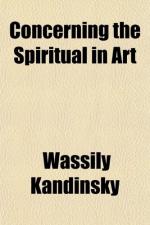The tendency of a work of art may be very simple, but provided it is not dictated by any external motive and provided it is not working to any material end, the harmony will be pure. The most ordinary action—for example, preparation for lifting a heavy weight—becomes mysterious and dramatic, when its actual purpose is not revealed. We stand and gaze fascinated, till of a sudden the explanation bursts suddenly upon us. It is the conviction that nothing mysterious can ever happen in our everyday life that has destroyed the joy of abstract thought. Practical considerations have ousted all else. It is with this fact in view that the new dancing is being evolved—as, that is to say, the only means of giving in terms of time and space the real inner meaning of motion. The origin of dancing is probably purely sexual. In folk-dances we still see this element plainly. The later development of dancing as a religious ceremony joins itself to the preceding element and the two together take artistic form and emerge as the ballet.
The ballet at the present time is in a state of chaos owing to this double origin. Its external motives—the expression of love and fear, etc.—are too material and naive for the abstract ideas of the future. In the search for more subtle expression, our modern reformers have looked to the past for help. Isadora Duncan has forged a link between the Greek dancing and that of the future. In this she is working on parallel lines to the painters who are looking for inspiration from the primitives.
[Footnote: Kandinsky’s example of Isadora Duncan is not perhaps perfectly chosen. This famous dancer founds her art mainly upon a study of Greek vases and not necessarily of the primitive period. Her aims are distinctly towards what Kandinsky calls “conventional beauty,” and what is perhaps more important, her movements are not dictated solely by the “inner harmony,” but largely by conscious outward imitation of Greek attitudes. Either Nijinsky’s later ballets: Le Sacre du Printemps, L’Apres-midi d’un Faune, Jeux, or the idea actuating the Jacques Dalcroze system of Eurhythmics seem to fall more into line with Kandinsky’s artistic forecast. In the first case “conventional beauty” has been abandoned, to the dismay of numbers of writers and spectators, and a definite return has been made to primitive angles and abruptness. In the second case motion and dance are brought out of the souls of the pupils, truly spontaneous, at. the call of the “inner harmony.” Indeed a comparison between Isadora Duncan and M. Dalcroze is a comparison between the “naturalist” and “symbolist” ideals in art which were outlined in the introduction to this book.—M.T.H.S.]
In dance as in painting this is only a stage of transition. In dancing as in painting we are on the threshold of the art of the future. The same rules must be applied in both cases. Conventional beauty must go by the board and the literary element of “story-telling” or “anecdote” must be abandoned as useless. Both arts must learn from music that every harmony and every discord which springs from the inner spirit is beautiful, but that it is essential that they should spring from the inner spirit and from that alone.




